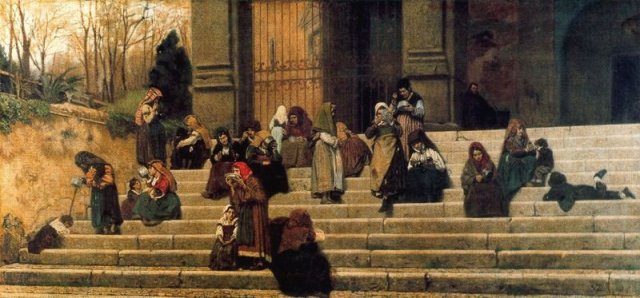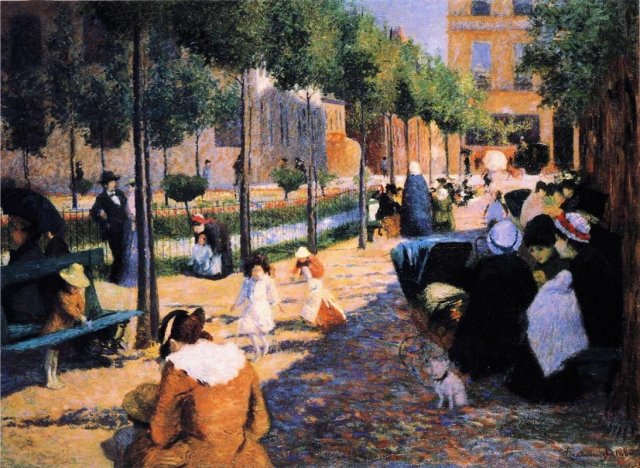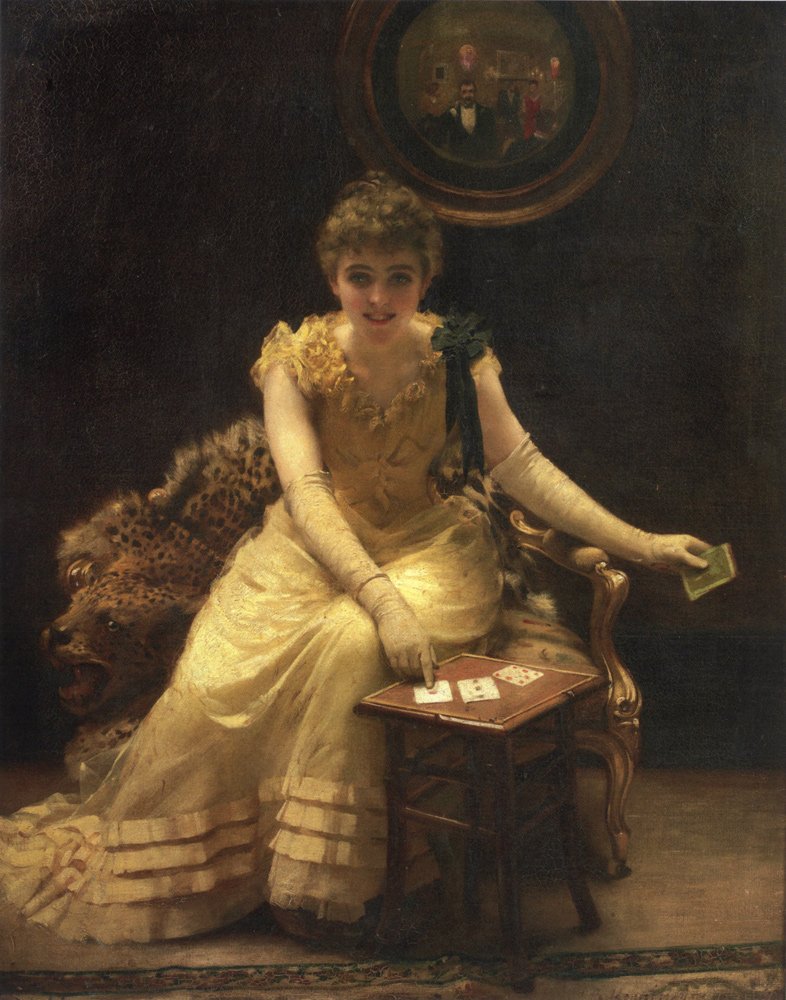
Today I am talking about Nikolai Petrovich Bogdanov-Belsky, who was one of the great nineteenth century Russian painters. The visual expression of the artist’s painting has its roots in realism, the desire to depict the reality of life.
Nikolai Petrovich Bogdanov was born on December 6th, 1868 in the small rural village of Shitiki of the Belsky district of the Smolensk province (today, the Oleninsky district of the Tver region) in the west of Russia, some 360 kilometres west-south-west of Moscow, and 60 kms from the border with Belarus. The second part of his name was attached only in 1905 when the artist received the title of Academician. Bogdanov-Belsky recalled this momentous event:
“...My common name was as though ennobled by the Emperor himself, writing it personally in a diploma with a hyphen – “Belsky…”
Nickolai came from a poor peasant family which in a Russian-language site was described as:
Он, внебрачный сын батрачки,
“He’ the illegitimate son of a batrachka“
A batrachka is defined as an order of amphibians which includes the frogs and toads. So, I guess that means his family was harshly classified as the lowest of the low ! Nikolai was born into a life of abject poverty and his childhood was harsh and unforgiving. He lived with his mother at the house of his uncle, where they were unwanted guests and merely tolerated. According to church records, Bogdanov-Belsky began learning to read and write from a bell ringer. He continued into the 2nd grade of the Shopotovsky primary school where the local priest was also the teacher. The boy’s artistic abilities began to manifest themselves from the age of six and he was noticed by Sergei Alexandrovich Rachinsky, the founder of the folk school in the village of Tatevo, and from the autumn of 1878 to the spring of 1882, Nickolai Bogdanov-Belsky attended this school. The boy worked hard and was helped along by Sergei Aleksandrovich Rachinsky and lived in the Rachinsky household. Rachinskyi was a legendary and wealthy man, who was a professor of biology, who lived on a large estate. Racznski had been Professor of Botany at Moscow University but left the scientific department in 1867 and created a school for peasant children on his estate in Tatev. However, to gain entrance to this school one had to pass an exam and in the case of Nicholai, he had to draw one of the school’s teachers in profile which is quite a difficult task for a child but his test piece was good enough for him to be accepted into the Sergei Aleksandrovich Rachinsky People’s School.
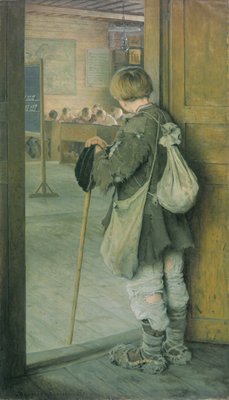
What was it like for Nickolai to face his first day at this new school? The answer probably lies in his 1897 autobiographical painting which he painted, aged twenty-nine. It was entitled On the Threshold of School. In it we see a boy holding his breath as he stood outside his classroom, plucking up the courage to enter.
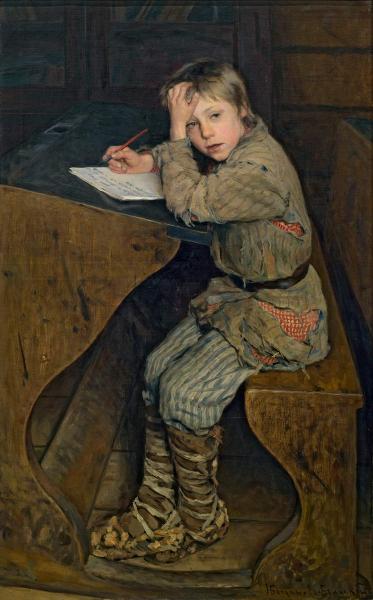
Another schoolroom scene was painted by Nikolai in 1908 simply entitled Writing.
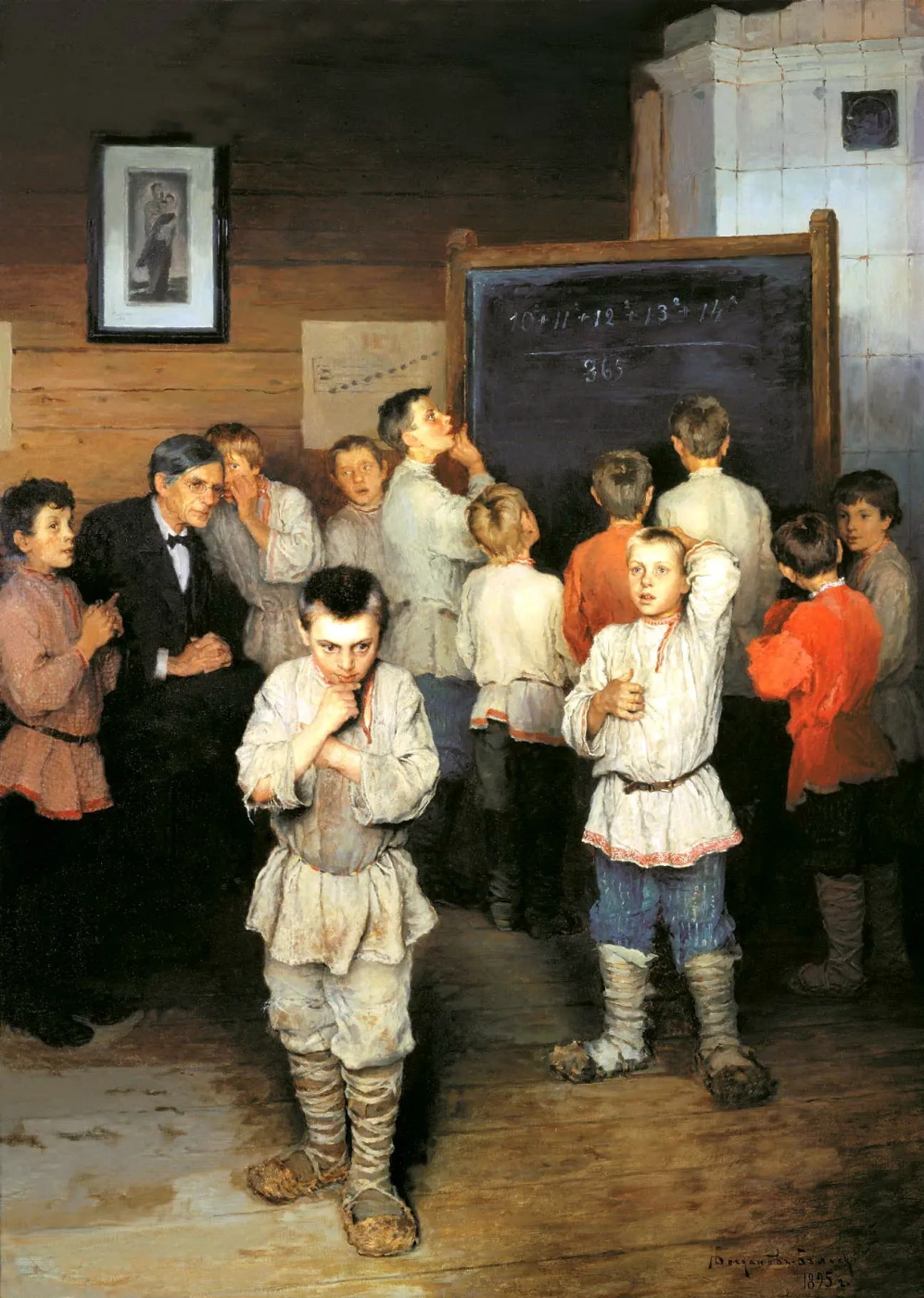
One of Nickolai’s well-known works featuring school life is his 1895 painting entitled Oral Counting which is also referred to as Verbal Counting or Mental Arithmetic. This is also Nikolai’s dedication to Sergei Aleksandrovich Rachinsky, a university professor and hereditary nobleman, who had befriended young Nikolai and set up a school which gave him and other barefoot peasant children from the village a start in life in the form of a decent education. In the painting, we see the figure of a schoolteacher, an intellectual in a bow tie and a black tailcoat seated among ordinary rural boys who have come to learn mathematics. The school room in the depiction is part of the school built with funds from Rachinsky in his ancestral village of Tatevo. It became the first Russian educational institution with full board for children of peasants. Nickolai Bogdanov-Belsky himself was fortunate enough to study there. Throughout his life, Nickolai would return with thoughts of gratitude remembering the warmth of school life and he devoted more and more of his new canvases to the teaching profession, and the process of schooling. There is no doubt that his years spent at the Rachinsky school left an indelible mark on his soul Rachinsky was very definite as to what the peasant classes needed, saying:
“…The first of the practical needs of the Russian people … is communication with the Divine…….The peasant is not drawn to the theatre in search of art, but to the church, not to the newspaper, but to the Divine Book…”
The reasoning behind this was that Rachinsky also believed that Dante and Shakespeare would be available for understanding to those who learnt Church Slavonic writing, while Beethoven and Bach would become closer to a person familiar with church chants.
Nicolai Bodanova-Belsky’s depiction testifies to Rachinsky’s main passion – mathematics, and the emphasis that was placed on it in his teaching. Rachinsky created the textbook entitled 1001 Problems for Oral Counting, and the puzzle seen on the blackboard in the painting is one such problem. Apparently, this example seen on the blackboard can be solved by knowing about the regularities of adding squares of some two-digit numbers named after the famous Russian teacher. So, according to Rachinsky’s sequences, the sum of the squares of the first three numbers on the board will be equal to the sum of the next two. And since in the first and second cases this number is 365, the answer to this already classical problem is extremely simple….. 2, but you knew that !!!!!!!!!
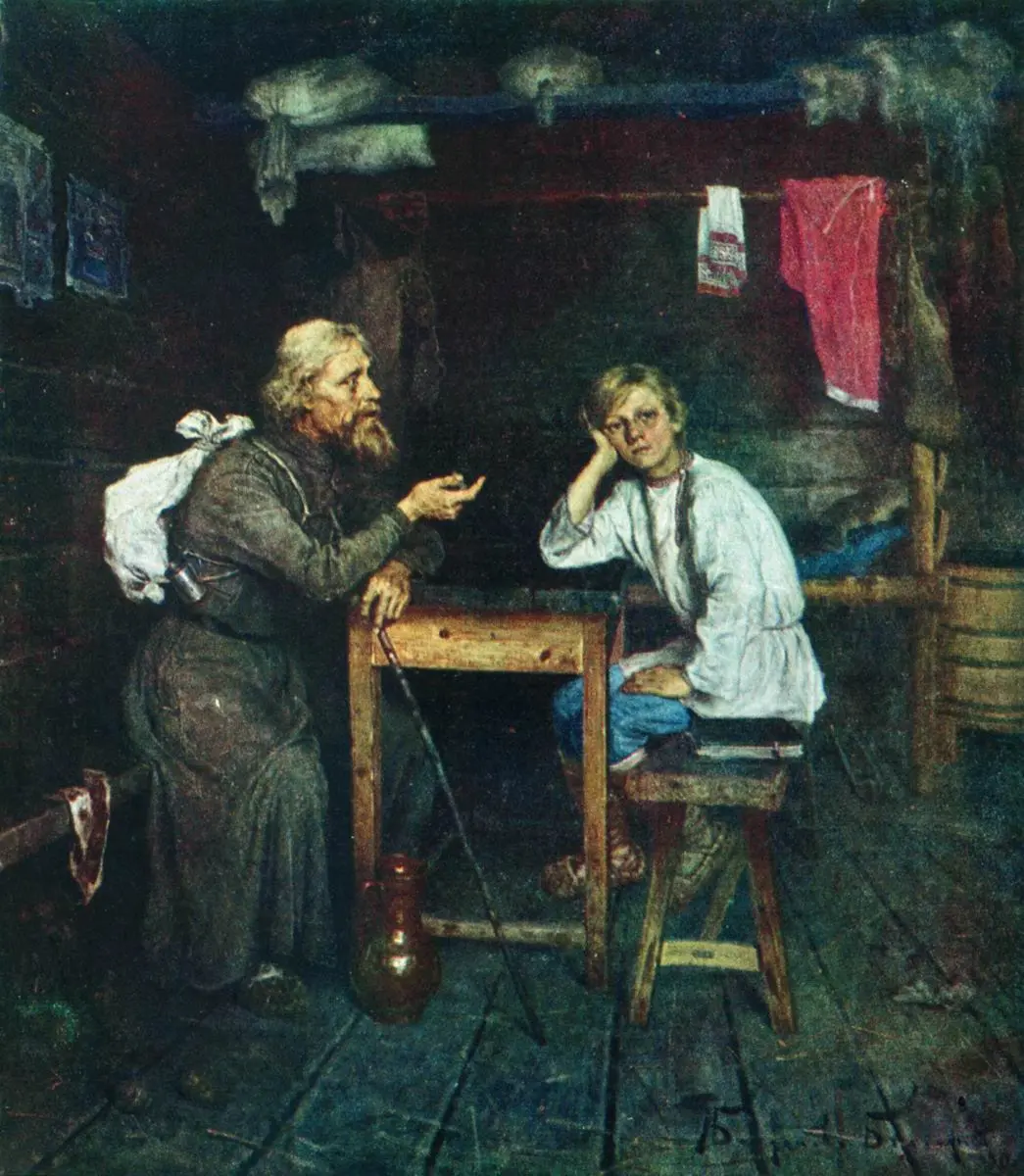
Future Monk by Nickolai Petrovich Bogdanov-Belsky (1889)
In 1881, Rachinsky sent thirteen-year-old Nickolai to receive an initial art education at the icon-painting workshop at the Trinity-Sergius Lavra, where the boy studied for two years. In 1884, after two years studying at the monastery school Rachinsky enabled Nickolai to enrol at the Moscow School of Painting and Architecture. He thrived at the school and achieved many commendations for his landscape work. He remained there for five years, and at the end of the course he had to produce a diploma painting, so as to receive the title of “class artist”. He was unsure what to paint although his fellow students and teachers presumed it would be a landscape painting. He decided to go back to the village of Tatevo to visit Raczynski and ask for his advice. Together they come up with the idea that the painting should feature monks. The painting he completed was entitled Future Monk. It seems the young teenager in the picture has set his sight on becoming a monk and to go to the monastery. The eyes of the “future monk” stare out at us with grim determination. He is already dreaming of monastic life and spiritual feats that it will bring. The work was approved by the examiners and bought from the exhibition by Kozma Terentievich Soldatenkov, the largest collector of works of art, and then given to by Empress Maria Fedorovna. Immediately the artist was ordered to paint two more versions of the painting. The painting had been an absolute success!

In 1890 Nickolai travelled to Constantinople and Mount Athos, a mountain and peninsula in northeastern Greece which is an important centre of Eastern Orthodox monasticism. On Athos, Bogdanov-Belsky met Filippe Malyavin, who is engaged in icon painting there. He also met sculptor Vladamir Beklemishev, a professor who later became the rector of the St. Petersburg Academy of Arts. Between 1894 and 1895 Nickolai is in St Petersburg where he continues his art studies at the St. Petersburg Academy of Arts. One of his lecturers was Ilya Repin. In 1895 Nickolai completes one of his best loved paintings, Sunday Reading. The painting is well received and is sold and with the money raised he goes to Paris, where he attends the private studios of Fernand Cormon and Filippo Colarossi.
There can be no doubt about the love Nickolai had for painting children of peasant stock. He would travel back and forth between St Petersburg where he rented an apartment and the village of Tatevo where he had his studio. He once wrote:
“…I spent so many years in the village, so close to the village school, so often I watched peasant children, so loved them for their spontaneity, their talent, that they became heroes of my paintings…”
In my final look at Bogdanov-Belsky’s peasant children paintings I want to show you his 1916 work entitled Country Boys. The main characters in this depiction are two bare-footed boys, one of whom is sitting on a rickety wattle-fence which appears to be just strong enough to support him. He wears a peaked cap on his head, which was a typical head gear of the 19th and early 20th centuries and sported by people in towns and rural settings alike. He is wearing a patched shirt and ill-fitting trousers with a hole at the knee. Something has distracted him making him turn to the side but we are unable to elicit what has caught his attention. His friend, standing beside him, is also wearing shabby clothes which could well have been “hand-me-down” ones from an elder brother. This is a Realism painting. The artist is simply depicting how things are for the rural poor. This is not a painting denouncing social inequality. In a way it is a poetic and lyrical depiction in the way Nickolai has given us a setting, a resplendent representation of nature, in which, behind the fence we see a chamomile field, forest and an overcast sky.
………………..to be continued.






















































